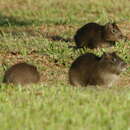en
names in breadcrumbs


The wild forms of the genus Cavia, which includes the domestic guinea pig (Cavia porcellus), are endemic to South America, occurring over most of the continent, with the exception of Amazonia and the southern portions of Chile and Argentina. They are associated primarily with grasslands, although they also occur around forest edges and swamps. Guinea pigs have long been associated with humans. Remains have been identified in archeological excavations from Peru and Colombia dating to at least 9,000 years bp and evidence suggests that domesticated guinea pigs have existed for at least the last 4,500 to 7,000 years, having been bred for food and ritual uses. Domestic guinea pigs continue to be bred by humans for use as food, as pets, and as laboratory animals. (Dunnum and Salazar-Bravo 2009 and references therein)
Dunnum and Salazar-Bravo 2009 reviewed recent efforts to understand the origin of the domesticated guinea pig. A variety of wild cavy species have been proposed as the progenitor of the domesticated guinea pig based on data ranging from behavior to molecular phylogenetic analyses. In contrast to early suggestions that guinea pigs were the result of multiple domestication events, which would imply that the domestic stock today is derived from multiple species or races, recent work has indicated that C. porcellus is likely the result of a single original domestication event, with subsequent diversification: an initial ancient domestication from a wild species to the domestic pre-Columbian guinea pig, still bred today as the ‘criollo’ (creole) variety throughout the Andean countries; a second step involving European peoples, who took a few creole guinea pigs several hundred years ago and transformed them into the present-day laboratory/pet guinea pig; and a third step involving a modern selection regime of creole guinea pigs to produce an improved animal for meat production. (Spotorno et al. 2006 and references therein). Analysis of molecular data and mummified guinea pigs from archaeological sites suggests several possible stock sources for the original domestication. Most probable appears to be C. tschudii from southern Peru, where the oldest archeological site with guinea pig remains (Ayamachay) is located. A second candidate is C. a. anolaimae from the highlands near Bogota, Colombia, where there is an archaeological site of similar age (Tequendama). A third, perhaps less likely, source population is C. patzelti from the highlands of Chimborazo, Ecuador. Based on their analysis and interpretation of available evidence, Dunnum and Salazar-Bravo conclude that domesticated C. porcellus most likely are derived from populations of C. t. tschudii from the coastal region around Ica, Peru (Spotorno et al. 2006; Dunnum and Salazar-Bravo 2009 and references therein)
Wild Cavia aperea (often considered to be the wild ancestor of the domestic guinea pig--but see above) are born in a highly precocial state and mature early in life, shortly after weaning. Trillmich et al. (2006) investigated the effect of the presence of adults of the opposite sex on age of maturation in C. aperea and C. porcellus. The authors found that social circumstances strongly influenced female age at maturity in both species. Females in the company of adult males matured earlier than those growing up in the exclusive company of same-age females. Male presence halved the time from birth to maturity.